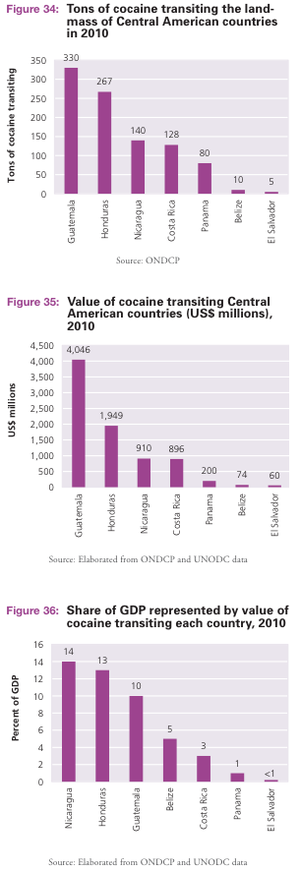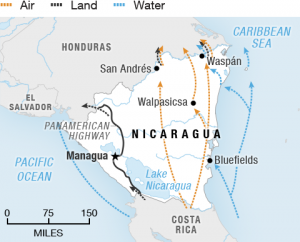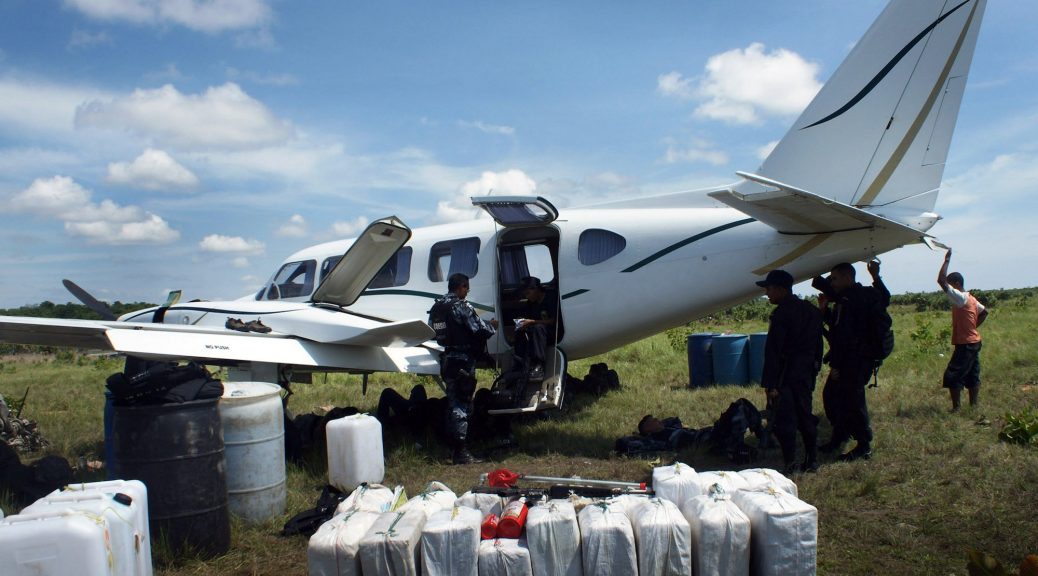Influence and History of Latin American Drug Trafficking on Nicaraguan Economic and Political Development
Drug trafficking has been widely apparent in Latin America for decades. It has been influencing the Americas since the 1970s and although many countries, like the United States, have invested billions of dollars creating anti-drug assistance programs, senseless amounts of illegal substances are transported every day. Many analysts say that this problem will exist forever. As of now, things are not pointing to change anytime soon. From factors including government corruption to cities that solely thrive off illegal trade, there is no simple treatment to the complex disease that is the market of illicit drugs. With my upcoming trip to Nicaragua, I wanted to learn more about how the illegal drug market has influenced the identity and stability of the country I will be soon entering.
 Latin America plays a key role in many global drug markets. According to the Congressional Research Service, “South America is the sole producer of cocaine for the global market; Mexico and Colombia are the primary sources of opiates in the United States; Mexico and the Caribbean are major foreign sources of cannabis (marijuana) consumed in the United States; and Mexico is the primary source of foreign methamphetamine in the United States. Marijuana and methamphetamine are also produced domestically.” Countries involved in facilitating the drug supply chain in the Americas can contribute in a number of way. This can consist of: drug trafficking, drug consumption, drug production, and drug crop cultivation. One of the many countries that is involved in the trade and is continuously getting suffering consequences is Nicaragua.
Latin America plays a key role in many global drug markets. According to the Congressional Research Service, “South America is the sole producer of cocaine for the global market; Mexico and Colombia are the primary sources of opiates in the United States; Mexico and the Caribbean are major foreign sources of cannabis (marijuana) consumed in the United States; and Mexico is the primary source of foreign methamphetamine in the United States. Marijuana and methamphetamine are also produced domestically.” Countries involved in facilitating the drug supply chain in the Americas can contribute in a number of way. This can consist of: drug trafficking, drug consumption, drug production, and drug crop cultivation. One of the many countries that is involved in the trade and is continuously getting suffering consequences is Nicaragua.

In the image above, NPR provides data elaborated from the United Nations Office on Drugs and Crime (UNODC) illustrating the vast impact cocaine trafficking has on the Nicaraguan economy. With about 140 tons of cocaine transited in 2010, Nicaragua is one of the leading countries in Central American in regards the quantity of cocaine that transferred on its landmass. This raises many questions. One of them being, “What happens if cocaine trafficking was eradicated completely in the country?” Figure 36 provides a shocking and unfortunate claim. Cocaine transported through Nicaragua illustrates the highest share of GDP than the rest of the Central American countries.

With cocaine trafficking acting as such a powerhouse of economic industry in the country, it simply acts as an unstoppable force in the country. For instance, the UNODC conducted a study in Central America on cocaine, organized crime groups, and violence. In the study, the three most widely recognized threats of the region include, “the flow of cocaine, the criminal groups this flow empowers, and the violence associated with both”. To put this in this perspective, in certain regions, these people found the previous threats to be more worrisome than issues such as human trafficking and trafficking on illegal weapons. It is an issue that currently seems cemented into the political and economic states of the country. The UNODC reported that while most murder rates of Central America are decreasing as of 2010, Nicaragua is the unfortunate exception. The sad reality to appearing to be that traffickers have so much power and influence on the amount of money the country manages that future corruption and violence is nearly inevitable. NPR interviewed Roberto Campbell, a storekeeper in Bluefields (see above image), Nicaragua, about learned more about how much the city depends on the drug trade. He says, “It’s not no secret. Everybody knows that. The big businesses from here, if there are no drugs around, they cannot sell their articles. So when you see things are good, that means drugs are around.” Considering how the city is reported to have a high unemployment rate yet its inner city is thriving, one could further see how the illicit substance market fuels the economies of certain regions.
Although there are programs that try to combat illegal drug trafficking, political agendas can come first at any time. For instance, one of the most examples in American history was in the 1980s during the Reagan Administration. During the Contra War, the US government had the goal of removing the Sandinistas as a major source of power in Nicaragua. Wanting to make the best political move, they viewed the Contras as a beneficial resource. Thus, the US provided aid to finance and arm the Contras for quite some time. A big topic of debate occurred when the tension peaked and the Iran-Contra affair occurred. During this time, cocaine trafficking was something that was relatively tolerated by the CIA, as it was seen to generate income for the Contra rebels. Although the CIA formally declined all allegations regarding the allowance of smuggling, many studies have shown this may not be the actual truth. On the other hand, there are many instances where the US seems to be completely anti-drug resistance. An example can be seen just two years ago when World Maritime News reported how US customs helped Nicaraguan law enforcement seize more than 679 pounds of cocaine, worth about $9.2 million, in the Caribbean Sea in November 2014.
As can be seen, illegal trafficking has a large spread of influence across Latin America and Nicaragua. Even though it has such positive momentum to stop anytime soon, there is certainly hope on dealing with the complex issue. Bookings Institution, a policy research group, says, “Illicit trafficking will never be completely eliminated, but it can be shaped to become less violent and increasingly marginal to the economies and societies of Latin America. There are countries that have succeeded in this endeavor, both relatively wealthy ones, such as Uruguay and Chile, and some of the poorest, such as Nicaragua.” Although Nicaragua is not in the best position at the moment, one should be highly interested on how the Nicaraguan government deals with the prevalent concern at hand. I look forward to staying informed on the topic and learning about what Nicaragua’s economic and political futures entail.

